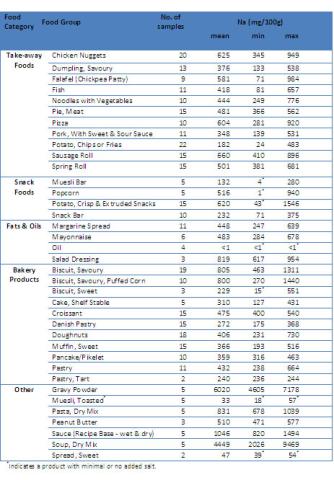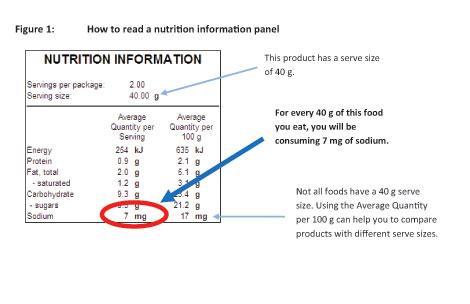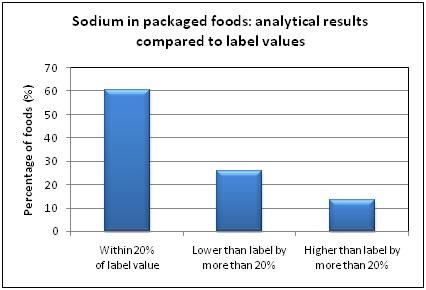Introduction
The level of sodium intake by Australians has been of growing interest in recent times. Most of the sodium in our food comes from sodium chloride (table salt), which is added to foods for flavour and as a preservative. Sodium also occurs naturally in almost all foods and can be present in processed foods due to the use of some food additives, for example, sodium bicarbonate (bi-carb soda or baking soda) used as a raising agent in cakes and biscuits.
In order to gather additional information on levels of sodium in a range of foods, FSANZ conducted an analytical survey of some packaged and take-away foods available in New South Wales and Western Australia. This data will be used to help conduct future dietary intake assessments of the Australian population and to contribute to information published in food composition tables such as NUTTAB.
The Survey
Sampling
From September 2008 to April 2009, a total of 363 samples of packaged and take-away foods were collected from a range of supermarkets and take-away shops across New South Wales and Western Australia. Of these samples, 277 were purchased from the suburbs of Sydney and 86 were from areas surrounding Perth.
Products from a range of different food categories were tested in the survey, as shown in Table 1.
Samples were collected at random to include a diverse range of products. For take-away food, samples were collected from various chain and independent retailers in both states and not selected based on market share. Thus the samples are not fully representative of national purchasing trends.
Analysis
Samples were transported in their original packaging to the laboratories for testing. All samples were tested without further preparation or cooking, except for one purchase of popcorn which was prepared in accordance with the on-pack product instructions.
Tests were conducted by two laboratories using inductively coupled plasma atomic emission spectroscopy (ICPAES) to a limit of detection of 1 mg/kg. NSW samples were analysed by Sydney West Area Health Service (SWAHS) and WA samples by ChemCentre.
Results
Average, minimum and maximum results for each food group are outlined in Table 1. The results for each individual product can be found on the FSANZ website.
Table 1: Number of samples and summary of results (mg/100g of food) for food groups tested in the survey
Discussion
Why is there such a big range of sodium in popcorn?
Some food groups in this survey showed a wide variation in sodium content. Popcorn is one of these foods, which saw sodium levels range from 1 mg/100 g to 940 mg/100 g. In this case, the popcorn with the low sodium content was popped in the laboratory and did not have any salt added before testing. The popcorn with the high sodium content was purchased ready-to-eat from a cinema and as such had salt added at the point of sale and salt from added butter. This is an example of discretionary use of salt and can make a big difference to an individual's sodium intake levels.
Why is there so much sodium in sweet biscuits?
Even sweet products often contain salt and other food additives which contain sodium. The sweet biscuits analysed in this survey ranged from 15 mg/100 g in a product which contained no added salt, to 551 mg/100 g in a product which contained added salt as well as sodium containing additives such as the food acid sodium citrate and raising agents such as sodium bicarbonate. This is an example of manufacturer differences, where the level of sodium in a product is determined by the company's prescribed formulation.
How can I select packaged foods which are low in sodium?
Most packaged food products that are sold in Australia are required to display a nutrition information panel (NIP) on the label. This panel contains information on the levels of energy, fats, protein, carbohydrates and sodium on a per serve and per 100 g basis. When shopping, you can look at the NIP to determine how much sodium is in the product. An example NIP is pictured at Figure 1.
The National Health and Medical Research Council (NHMRC) recommend that Australian adults consume less than 2,300 mg of sodium per day. This is equivalent to about 6 g or 1 teaspoon of salt. As a general guide, if you are looking to reduce levels of sodium intake, a 'low salt' food is defined by the Australia New Zealand Food Standards Code as a food with a sodium concentration of no more than 120 mg/100 g.
Figure 1: How to read a nutrition information panel
How much sodium is there in salt?
1 g of salt contains approximately 400 mg of sodium. Using the results of this survey, if you were to eat a meat pie with a bucket of chips you would be consuming 1045 mg of sodium. That is equivalent to 2.5 g or half a teaspoon of salt. That is half of the maximum daily amount recommended by the NHMRC.
How reliable are label sodium values?
Around half (165 out of 363) of the samples collected during this survey displayed an NIP. Of these samples, 60% of the analysed sodium values were within 20% of the level reported on the label. As depicted in Figure 2, the majority of the remaining samples had sodium values lower than that reported on the NIP. This means that, for the foods included in this survey, over 85% had sodium levels that were close to or lower than the value reported on the label.
Figure 2: Comparison of results for sodium in packaged foods analysed in this survey with their label values.
Future directions
The results of this survey showed a wide range in sodium levels within the packaged and take-away food categories included in this program. This may be due to brand-specific formulations in products such as biscuits and potato crisps and discretionary salt usage by consumers and food preparation personnel for take-away foods such as potato chips and fish.
FSANZ will continue to monitor levels of sodium in these food categories along with other food products available for consumption in Australia. This will enable some tracking of industry and consumer trends in salt and sodium usage to ensure the most robust data sets are available for use in dietary intake assessments and nutrition guidance.
- Appendix 1: Individual Product Results



